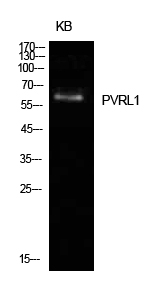Nectin 1 Polyclonal Antibody
- Catalog No.:YT5602
- Applications:WB;ELISA
- Reactivity:Human;Mouse;Rat
- Target:
- Nectin 1
- Fields:
- >>Cell adhesion molecules;>>Adherens junction;>>Herpes simplex virus 1 infection
- Gene Name:
- PVRL1
- Protein Name:
- Poliovirus receptor-related protein 1
- Human Gene Id:
- 5818
- Human Swiss Prot No:
- Q15223
- Mouse Gene Id:
- 58235
- Mouse Swiss Prot No:
- Q9JKF6
- Immunogen:
- The antiserum was produced against synthesized peptide derived from the Internal region of human PVRL1. AA range:81-130
- Specificity:
- Nectin 1 Polyclonal Antibody detects endogenous levels of Nectin 1 protein.
- Formulation:
- Liquid in PBS containing 50% glycerol, 0.5% BSA and 0.02% sodium azide.
- Source:
- Polyclonal, Rabbit,IgG
- Dilution:
- WB 1:500 - 1:2000. ELISA: 1:10000. Not yet tested in other applications.
- Purification:
- The antibody was affinity-purified from rabbit antiserum by affinity-chromatography using epitope-specific immunogen.
- Concentration:
- 1 mg/ml
- Storage Stability:
- -15°C to -25°C/1 year(Do not lower than -25°C)
- Other Name:
- PVRL1;HVEC;PRR1;Poliovirus receptor-related protein 1;Herpes virus entry mediator C;Herpesvirus entry mediator C;HveC;Herpesvirus Ig-like receptor;HIgR;Nectin-1;CD111
- Observed Band(KD):
- 57kD
- Background:
- This gene encodes an adhesion protein that plays a role in the organization of adherens junctions and tight junctions in epithelial and endothelial cells. The protein is a calcium(2+)-independent cell-cell adhesion molecule that belongs to the immunoglobulin superfamily and has 3 extracellular immunoglobulin-like loops, a single transmembrane domain (in some isoforms), and a cytoplasmic region. This protein acts as a receptor for glycoprotein D (gD) of herpes simplex viruses 1 and 2 (HSV-1, HSV-2), and pseudorabies virus (PRV) and mediates viral entry into epithelial and neuronal cells. Mutations in this gene cause cleft lip and palate/ectodermal dysplasia 1 syndrome (CLPED1) as well as non-syndromic cleft lip with or without cleft palate (CL/P). Alternative splicing results in multiple transcript variants encoding proteins with distinct C-termini. [provided by RefSeq, Oct 2009],
- Function:
- disease:Defects in PVRL1 are the cause of ectodermal dysplasia Margarita Island type (EDMI) [MIM:225060]; also known as Zlotogora-Ogur syndrome, cleft lip/palate-ectodermal dysplasia syndrome (CLPED1) or ectodermal dysplasia 4. Ectodermal dysplasia defines a heterogeneous group of disorders due to abnormal development of two or more ectodermal structures. EDMI is an autosomal recessive syndrome characterized by the association of cleft lip/palate, ectodermal dysplasia (sparse short and dry scalp hair, sparse eyebrows and eyelashes), and partial syndactyly of the fingers and/or toes. Two thirds of the patients do not manifest oral cleft but present with abnormal teeth and nails.,disease:Defects in PVRL1 are the cause of non-syndromic orofacial cleft type 7 (OFC7) [MIM:225060]. Non-syndromic orofacial cleft is a common birth defect consisting of cleft lips with or without cleft palate. Cle
- Subcellular Location:
- [Isoform Alpha]: Cell membrane; Single-pass type I membrane protein. Cell junction, synapse, presynaptic cell membrane .; [Isoform Delta]: Cell membrane; Single-pass type I membrane protein.; [Isoform Gamma]: Secreted.
- Expression:
- Brain,Plasma,
- June 19-2018
- WESTERN IMMUNOBLOTTING PROTOCOL
- June 19-2018
- IMMUNOHISTOCHEMISTRY-PARAFFIN PROTOCOL
- June 19-2018
- IMMUNOFLUORESCENCE PROTOCOL
- September 08-2020
- FLOW-CYTOMEYRT-PROTOCOL
- May 20-2022
- Cell-Based ELISA│解您多样本WB检测之困扰
- July 13-2018
- CELL-BASED-ELISA-PROTOCOL-FOR-ACETYL-PROTEIN
- July 13-2018
- CELL-BASED-ELISA-PROTOCOL-FOR-PHOSPHO-PROTEIN
- July 13-2018
- Antibody-FAQs
- Products Images

- Western Blot analysis of KB cells using Nectin 1 Polyclonal Antibody. Secondary antibody(catalog#:RS0002) was diluted at 1:20000
.jpg)
- Western Blot analysis of KB cells using Nectin 1 Polyclonal Antibody. Secondary antibody(catalog#:RS0002) was diluted at 1:20000



